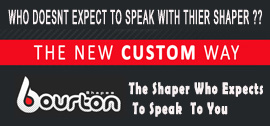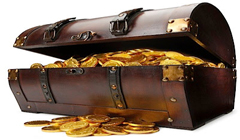First of all there is a story behind the name of this model which probably needs to be explained before I get into the technical. My label consists of about 20 different models which is probably nearly too many. These days however, there are so many different categories available since the market has diversified so much that you cannot possibly 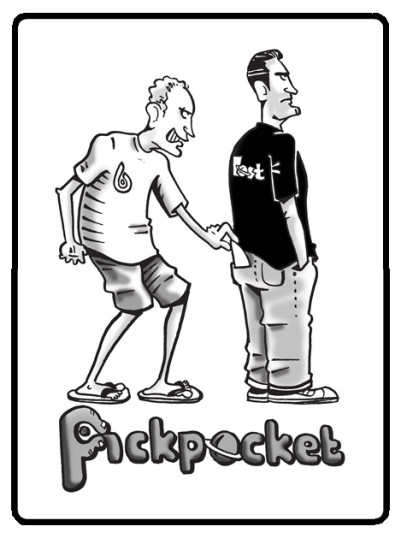 incorporate every type of design in your range.
incorporate every type of design in your range.
I had been asked by a loyal customer to design him a board similar to the Lost “Sub Scorcher”. At the time I had not heard of the design (he was a good mate so I made the effort) so I went into my old shop at Cooly to check one out so I could get an idea what he was on about.
Being a shaper I am always packing a tape measure so I ran a few measurements over the thing so I could get close enough to keep him happy. I know Matt Biolos personally, so I know he wouldn’t give a shit just like I wouldn’t, in fact this is what drives innovation – designers taking bits and pieces from each other and put them into their own creations.
In this particular case it was a little more than just bits and pieces though, because I literally copied it exactly (as I said he was a good mate). So I guess by now you may have figured out why I have named it the “Pick Pocket”.
Anyway to my surprise my mate really loved the board and a few more of his mates ordered one and they also loved the way it went. The pressure was on for me to make a model so out of respect for Matt I made a few little changes which I thought were necessary anyway, particularly for Australian conditions.
THE MODEL DIMENSIONS- 6.0 X 20 X 2 ½
ROCKER – Relatively flat throughout with no sudden flips at either end
PLANSHAPE- Wide nose and tail with a moderate hip positioned in line with the leading edge of the front side fins
BOTTOM SHAPE- Single double concave deepest between the two feet. Small release vee out the tail
RAILS- Chunky by nature but I have dropped them down a little from the original
TAIL SHAPE- The tail is a full squash which is well on the wide side for a thruster.
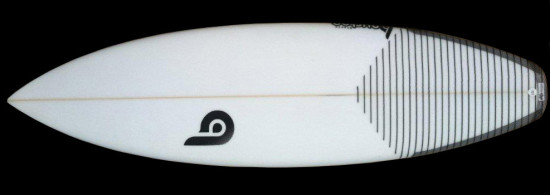
SUMMARY The Sub Scorcher is a typical American East Coast board designed to run in powerless waves. The main feature is the flat rocker that will run in anything. Add to that the extra width which also adds planning speed in these waves. All these things do make a board like this stiff but American shapers have worked out how to loosen up such a stiff rocker by using the planshape hip to free up this stiffness. Also the back fin is clustered closer to the front fins and is a tad smaller than the fronts again to etch back some east- west.
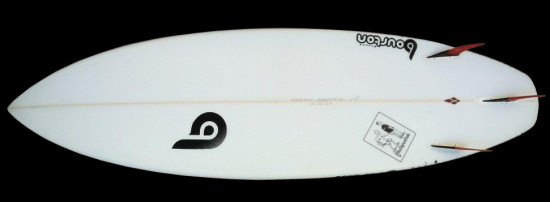
Well all this will work providing you do not intend to launch a design like this into hollow powerful reef waves as it really is designed to be a runner in small beachies prevalent on the East Coast of the USA. Perhaps the relevance of this sort of board here in Oz is that the bulk of our surfing population reside in our capital cities which are not really known for full barrelling waves so there is an application for a board like this for sure.
I couldn’t help myself having a little tweak off the original copy however. I thought the tail was a little too wide and chunky , so I thinned it a little and narrowed the squash tail a little as well so it would not go sideways in waves around 4 ft. I also emphasised the tail vee a little, just to help decrease the tail pressure for the same above reason.
I did not mess with the engine (the rocker) as this was its main attribute although I was tempted. I stayed with the rear fin clustered closer to the front fins because of the amount of nose area this thruster has to 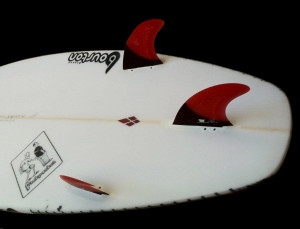 contend with. A tighter cluster allows the board to be surfed further forward and have more command over a front heavy planshape. It does not do much for tail slide security but is a necessary trade-off for a wide nose and I think the reduction in the tail area here should do the trick for this problem anyway.
contend with. A tighter cluster allows the board to be surfed further forward and have more command over a front heavy planshape. It does not do much for tail slide security but is a necessary trade-off for a wide nose and I think the reduction in the tail area here should do the trick for this problem anyway.
On the glassing front we have effectively eradicated tail cancer with the carbon tail rail reinforcement, but there are still many that destroy the deck in the tail area so much so the FCS plugs can pop out the deck. Being a smaller wave board also means there is a lot more pressure exerted on the tail to get a board like this going in gutless surf so the deck gets a caning. I have added a toe patch with a little extra carbon strength to give the tail deck some more dent strength.
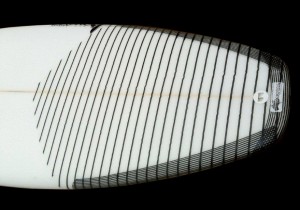 I have also became a believer in the opportunity to adjust the rear fins to either just personalize the cluster or in deed give the board a little more grip in bigger waves and more pivot in smaller waves
I have also became a believer in the opportunity to adjust the rear fins to either just personalize the cluster or in deed give the board a little more grip in bigger waves and more pivot in smaller waves
Ive employed the Power base fin system in this model to give it this function. For inner metropolitan beaches the Pick Pocket should excel because it will run and pivot on anything and with the few little tweaks I have incorporated hopefully you could have a stab at waves with a little more consequence.
Thank s Matt for the inspiration!
RANGE
5.6 X 19 ¼ X 2 5/16
5.8 X 19 ½ X 2 3/8
5.10 X 19 ¾ X 2 7/16
6.0 X 20 X 2 ½
6.2 X 20 ¼ X 2 9/16
6.4 X 20 ½ X 2 5/8
6.6 X 20 ¾ X 2 3/4
——————————————————————————-
The funnest small wave board.I rode 5’11x 20 1/4 x 2 5/8″ This board can be ridden thick because when the waves are gutless, why struggle to get up to speed. The board paddles exceptionally. I am riding three inches shorter than usual. The best thing about this board is it never loses speed. It traverses flat sections like a Simmons and you get to the oncoming wave with speed to do a rebound no wiggling required. It is also very user friendly as in your feet have a large area of positioning without bogging occurring or continual shuffling being required
Yo
Dan Naughton
